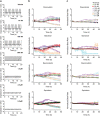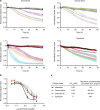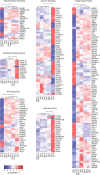Anthracycline-Induced Cardiotoxicity: Molecular Insights Obtained from Human-Induced Pluripotent Stem Cell-Derived Cardiomyocytes (hiPSC-CMs)
- PMID: 33719006
- PMCID: PMC7956936
- DOI: 10.1208/s12248-021-00576-y
Anthracycline-Induced Cardiotoxicity: Molecular Insights Obtained from Human-Induced Pluripotent Stem Cell-Derived Cardiomyocytes (hiPSC-CMs)
Abstract
Anthracyclines are a class of chemotherapy drugs that are highly effective for the treatment of human cancers, but their clinical use is limited by associated dose-dependent cardiotoxicity. The precise mechanisms by which individual anthracycline induces cardiotoxicity are not fully understood. Human-induced pluripotent stem cell-derived cardiomyocytes (hiPSC-CMs) are emerging as a physiologically relevant model to assess drugs cardiotoxicity. Here, we describe an assay platform by coupling hiPSC-CMs and impedance measurement, which allows real-time monitoring of cardiomyocyte cellular index, beating amplitude, and beating rate. Using this approach, we have performed comparative studies on a panel of four anthracycline drugs (doxorubicin, epirubicin, idarubicin, and daunorubicin) which share a high degree of structural similarity but are associated with distinct cardiotoxicity profiles and maximum cumulative dose limits. Notably, results from our hiPSC-CMs impedance model (dose-dependent responses and EC50 values) agree well with the recommended clinical dose limits for these drugs. Using time-lapse imaging and RNAseq, we found that the differences in anthracycline cardiotoxicity are closely linked to extent of cardiomyocyte uptake and magnitude of activation/inhibition of several cellular pathways such as death receptor signaling, ROS production, and dysregulation of calcium signaling. The results provide molecular insights into anthracycline cardiac interactions and offer a novel assay system to more robustly assess potential cardiotoxicity during drug development.
Keywords: anthracycline; cardiotoxicity; cellular model; hiPSC-CMs.
Figures








Similar articles
-
Identification of genomic biomarkers for anthracycline-induced cardiotoxicity in human iPSC-derived cardiomyocytes: an in vitro repeated exposure toxicity approach for safety assessment.Arch Toxicol. 2016 Nov;90(11):2763-2777. doi: 10.1007/s00204-015-1623-5. Epub 2015 Nov 4. Arch Toxicol. 2016. PMID: 26537877 Free PMC article.
-
Human induced pluripotent stem cell-derived cardiomyocytes recapitulate the predilection of breast cancer patients to doxorubicin-induced cardiotoxicity.Nat Med. 2016 May;22(5):547-56. doi: 10.1038/nm.4087. Epub 2016 Apr 18. Nat Med. 2016. PMID: 27089514 Free PMC article.
-
Cardiac Toxicity From Ethanol Exposure in Human-Induced Pluripotent Stem Cell-Derived Cardiomyocytes.Toxicol Sci. 2019 May 1;169(1):280-292. doi: 10.1093/toxsci/kfz038. Toxicol Sci. 2019. PMID: 31059573 Free PMC article.
-
Moving beyond the comprehensive in vitro proarrhythmia assay: Use of human-induced pluripotent stem cell-derived cardiomyocytes to assess contractile effects associated with drug-induced structural cardiotoxicity.J Appl Toxicol. 2018 Sep;38(9):1166-1176. doi: 10.1002/jat.3611. Epub 2018 Feb 27. J Appl Toxicol. 2018. PMID: 29484688 Review.
-
New signal transduction paradigms in anthracycline-induced cardiotoxicity.Biochim Biophys Acta. 2016 Jul;1863(7 Pt B):1916-25. doi: 10.1016/j.bbamcr.2016.01.021. Epub 2016 Jan 29. Biochim Biophys Acta. 2016. PMID: 26828775 Review.
Cited by
-
Cinnamic Acid Derivatives as Cardioprotective Agents against Oxidative and Structural Damage Induced by Doxorubicin.Int J Mol Sci. 2021 Jun 9;22(12):6217. doi: 10.3390/ijms22126217. Int J Mol Sci. 2021. PMID: 34207549 Free PMC article.
-
Informing Hazard Identification and Risk Characterization of Environmental Chemicals by Combining Transcriptomic and Functional Data from Human-Induced Pluripotent Stem-Cell-Derived Cardiomyocytes.Chem Res Toxicol. 2024 Aug 19;37(8):1428-1444. doi: 10.1021/acs.chemrestox.4c00193. Epub 2024 Jul 24. Chem Res Toxicol. 2024. PMID: 39046974 Free PMC article.
-
To PEGylate or not to PEGylate: Immunological properties of nanomedicine's most popular component, polyethylene glycol and its alternatives.Adv Drug Deliv Rev. 2022 Jan;180:114079. doi: 10.1016/j.addr.2021.114079. Epub 2021 Dec 10. Adv Drug Deliv Rev. 2022. PMID: 34902516 Free PMC article. Review.
-
Research Progress on the Mechanism, Monitoring, and Prevention of Cardiac Injury Caused by Antineoplastic Drugs-Anthracyclines.Biology (Basel). 2024 Sep 3;13(9):689. doi: 10.3390/biology13090689. Biology (Basel). 2024. PMID: 39336116 Free PMC article. Review.
-
Two-dimensional speckle tracking echocardiography help identify breast cancer therapeutics-related cardiac dysfunction.BMC Cardiovasc Disord. 2022 Dec 15;22(1):548. doi: 10.1186/s12872-022-03007-8. BMC Cardiovasc Disord. 2022. PMID: 36522712 Free PMC article.
References
-
- Venkatesh P, Kasi A. Anthracyclines. Treasure Island (FL): StatPearls; 2020.
Publication types
MeSH terms
Substances
Grants and funding
LinkOut - more resources
Full Text Sources
Other Literature Sources

